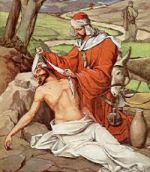The Recognition of Fr. Damien
By Dr. Jeff Mirus ( bio - articles - email ) | Feb 14, 2011 | In Reviews
On October 11, 2009, Fr. Damien of Molokai, the Leper Priest, was canonized by Pope Benedict XVI in St. Peter’s Basilica. He was a rough and ready man with a will of iron and a heart of gold. At the age Christ died, Damien began an unbroken ministry to the lepers on the Hawaiian island of Molokai, a ministry carried on mostly alone, and one from which he would be released only by his death from the same disease sixteen years later in 1889.
Free eBook:

|
| Free eBook: The Books of the New Testament |
By that time, Fr. Damien, a Belgian Sacred Hearts missionary who began life as Jef De Veuster, had made his mark not only on the leper colony but, without even trying, on the late 19th century world, which was inspired by his single-hearted love much as the late 20th century world would be inspired by Mother Teresa of Calcutta. But Fr. Damien’s immediate superiors were often less inspired than the rest of the world. Where much of the world saw single-minded devotion, his superiors often described Damien as short-sighted, attached to his own will, and insufficiently grateful for the work of others.
In the end, the Church decided that the shoe was really on the other foot. But because of some of these testimonies against him, it took a long time, nearly 90 years, for Damien’s virtue to be declared heroic so that he could be named Venerable. After that, Mother Teresa and the poorest of the poor around the world took up the cause, continuing to press Pope John Paul II until she was able to attend Damien’s beatification Mass in 1995. It may come as a surprise, but Mother Teresa felt she needed a saint of Damien’s mettle to inspire her Congregation to still greater service.
You can read about what made Damien great in Jan De Volder’s new biography, The Spirit of Father Damien, translated into English by John Steffen and published by Ignatius Press. The book not only provides all the necessary detail to fill in Damien’s life on Molokai and his relationships with his superiors, but it takes a clear look at Damien’s personality, both his weaknesses and his strengths, and ably charts the development of his spirituality from a youthful enthusiasm for missionary battle to a deep serenity which, by the end of his life, nothing could shake.
When examining the life of a leper, the outward flaws of the flesh force one to remember that, even for saints, the interior life also has flaws. A work in progress, holiness is a process as much as it is a fact. Over the centuries, different cultures have portrayed saints in different ways. In some periods, authors and their audiences have been captivated by the miraculous; in others it is the heroic virtue that inspires; in still others, there is a deep interest in the saint’s human side, his struggles, his failures and his triumphs. In a highly critical (and frequently dubious) age such as our own, there is a desire to see what a saint was like in the absence of grace (if that were possible). How much of his life can be explained by his human nature alone?
De Volder does not fall into the trap of attempting to isolate the supernatural, and he certainly has no desire to exclude it, but neither is he blind to the raw natural material. We see the cocky young Damien reminding his parents of their pious duties as if, should he fail to speak, those who had raised a strong Catholic family might not seek God. We notice that he delights far too much, or at least too openly, when his older brother Pamphile became too sick to go on the mission to Hawaii so that Damien was able to take his place. We see his impatience with superiors who, unlike Damien, had to juggle a far wider range of concerns than were represented by the leper colony on Molokai. We overhear conflicts with those assigned (occasionally!) to assist him, even if these conflicts were, in the main, not of Damien’s making. We observe Damien’s competition with rival missionary groups. We share his occasional complaints.
But it is precisely the single-minded devotion to their mission and to those in their charge which make saints so difficult to appreciate by those of us who are “more balanced”. De Volder paints for us a picture of Damien giving his life, wholeheartedly from the first, but still step by excruciating step, to those exiled to Molokai, torn away by force from their friends and family in order to prevent the spread of the dread disease. We see Damien taking great care to protect visitors from contagion while he himself ate from the same pot and shared his pipe with the living dead. We see him administering the sacraments, catechizing and converting, burying the dead (often more than one per day), taking in orphans, driving out dissipation, building homes and churches, attempting new medical treatments, organizing his people and offering both purpose and hope.
We also see him maintaining a life of rigorous prayer, several hours in each day when he would do his best to avoid being disturbed, precisely so he could grow spiritually, retain his resolve, and succeed in doing good for the rest of the day, always suspicious of his own weakness, always insistent on drawing strength from the Eucharistic Christ. And we see him physically isolated, painfully alone, longing for a confrere as his Order’s rule required, often having no one to confess to, almost never visited by his squeamish superiors, frequently misunderstood, and isolated spiritually too, accused of pride and vainglory because he insisted again and again on his lepers’ need of more and better help.
For my tastes, at least, Jan De Volder strikes just the right balance. Damien emerges as a man I can appreciate, because he was a man, yet one I can imitate, because he was a saint. And to return to his superiors one last time, De Volder also gives us a lucid account of the efforts to raise Damien to the altars, the difficulty of overcoming their negative testimonies, and the way in which it was ultimately proved beyond reasonable doubt that the fault was more on their side than on Damien’s. This opens a window not only into the life of a great saint, but into the vagaries of a saint’s cause. It is a reminder that holiness must endure even when recognition is lacking, but that in the Church’s own time and God’s—and not for the saint’s own sake but for ours—recognition too may come.
All comments are moderated. To lighten our editing burden, only current donors are allowed to Sound Off. If you are a current donor, log in to see the comment form; otherwise please support our work, and Sound Off!







